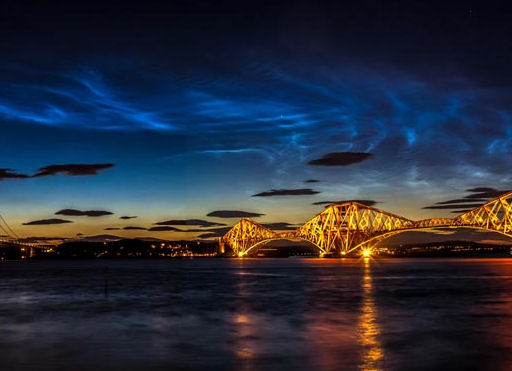SUNRISE SKY SHOW: Venus and Jupiter are converging in the morning sky for a close encounter in the early weeks of July. Set your alarm for dawn and look east. It's a nice way to start the day. [images]
COMING ATTRACTION? An active sunspot on the farside of the sun is only days away from showing itself. During the late hours of June 25th, NASA's Solar Dynamics Observatory recorded an explosion which heralds the sunspot's approach:
The farside blast hurled a cloud of plasma over the sun's southeastern limb. Earth was not in the line of fire, but Mars might be. The Solar and Heliospheric Observatory saw a coronal mass ejection (movie) heading in the general direction of the Red Planet. The rover Curiosity, en route to Mars now, might detect something as the cloud passes by. A glancing blow to Mars itself is possible on June 29th or 30th.
ELECTRIC-BLUE CLOUDS: Yesterday, high above Earth's surface where our planet's atmosphere meets the vacuum of space, a ray of sunlight hit a wispy, rippling bank of icy noctilucent clouds (NLCs). They lit up, glowing electric-blue, producing this apparition over Queensferry, Scotland:
"A stitch of 2 images shows the broad extent of the display last night," says photographer Adrian Maricic. "It was bright and vivid, the best of the 2012 noctilucent cloud season so far for us in Scotland!"
Normally confined to Arctic latitudes, the intense NLCs of June 25, 2012, dipped all the way down to the south coast of England: "This was my first sighting of 2012," says Pete Lawrence, who photographed the southern edge of the bank from Selsey UK.
In recent years, the "habitat" of noctilucent clouds has been expanding. Breaking through the barriers of high-latitude that once kept them bottled up in the Arctic, NLCs have been sighted as far south as Colorado, Virginia, Kansas, and Utah. Here are some examples of sightings in the lower United States.
Observing tips: Look west 30 to 60 minutes after sunset when the sun has dipped 6o to 16o below the horizon. If you see luminous blue-white tendrils spreading across the sky, you've probably spotted a noctilucent cloud.

![]()
Solar wind
speed: 461.6 km/sec
density: 4.6 protons/cm3
explanation | more data
Updated: Today at 1446 UT
![]()
X-ray Solar Flares
6-hr max: C1 1255 UT Jun26
24-hr: C1 1255 UT Jun26
explanation | more data
Updated: Today at: 1400 UT
![]()
![]()
![]()
Daily Sun: 26 Jun 12
![]()
![]()
Sunspot 1512 poses a threat for C-class solar flares. Credit: SDO/HMI
![]()
![]()
![]()
Sunspot number: 14
What is the sunspot number?
Updated 26 Jun 2012
Spotless Days
Current Stretch: 0 days
2012 total: 0 days (0%)
2011 total: 2 days (<1%)
2010 total: 51 days (14%)
2009 total: 260 days (71%)
Since 2004: 821 days
Typical Solar Min: 486 days
Updated 26 Jun 2012
The Radio Sun
10.7 cm flux: 89 sfu
explanation | more data
Updated 26 Jun 2012
![]()
![]()
![]()
Current Auroral Oval:
![]()
Switch to: Europe, USA, New Zealand, Antarctica
Credit: NOAA/POES
![]()
![]()
![]()
Planetary K-index
Now: Kp= 2 quiet
24-hr max: Kp= 3 quiet
explanation | more data
![]()
Interplanetary Mag. Field
Btotal: 4.7 nT
Bz: 0.8 nT north
explanation | more data
Updated: Today at 1446 UT
![]()
![]()
![]()
Coronal Holes: 26 Jun 12
![]()
![]()
Solar wind flowing from this coronal hole should reach Earth on July 1-2. Credit: SDO/AIA.






